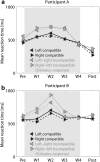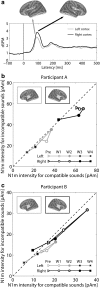A wearable system for adaptation to left-right reversed audition tested in combination with magnetoencephalography
- PMID: 30603167
- PMCID: PMC6208503
- DOI: 10.1007/s13534-017-0026-3
A wearable system for adaptation to left-right reversed audition tested in combination with magnetoencephalography
Abstract
Exposure of humans to unusual spaces is effective to observe the adaptive strategy for an environment. Though adaptation to such spaces has been typically tested with vision, little has been examined about adaptation to left-right reversed audition, partially due to the apparatus for adaptation. Thus, it is unclear if the adaptive effects reach early auditory processing. Here, we constructed a left-right reversed stereophonic system using only wearable devices and asked two participants to wear it for 4 weeks. Every week, the magnetoencephalographic responses were measured under the selective reaction time task, where they immediately distinguished between sounds delivered to either the left or the right ear with the index finger on the compatible or incompatible side. The constructed system showed high performance in sound localization and achieved gradual reduction of a feeling of strangeness. The N1m intensities for the response-compatible sounds tended to be larger than those for the response-incompatible sounds until the third week but decreased on the fourth week, which correlated with the initially shorter and longer reaction times for the compatible and incompatible conditions, respectively. In the second week, disruption of the auditory-motor connectivity was observed with the largest N1m intensities and the longest reaction times, irrespective of compatibility. In conclusion, we successfully produced a high-quality space of left-right reversed audition using our system. The results suggest that a 4-week exposure to the reversed audition causes optimization of the auditory-motor coordination according to the new rule, which eventually results in the modulation of early auditory processing.
Keywords: Auditory adaptation; Early auditory processing; Magnetoencephalography (MEG); Neural plasticity; Stimulus-response compatibility; Unusual environment.
Conflict of interest statement
The authors declare that they have no conflicts of interest in relation to this article.
Figures







Similar articles
-
A Method to Study Adaptation to Left-Right Reversed Audition.J Vis Exp. 2018 Oct 29;(140):56808. doi: 10.3791/56808. J Vis Exp. 2018. PMID: 30417871 Free PMC article.
-
Automatic and imperative motor activations in stimulus-response compatibility: magnetoencephalographic analysis of upper and lower limbs.Exp Brain Res. 2006 Jan;168(1-2):51-61. doi: 10.1007/s00221-005-0090-2. Epub 2005 Aug 3. Exp Brain Res. 2006. PMID: 16078021
-
The contribution of high frequencies to human brain activity underlying horizontal localization of natural spatial sounds.BMC Neurosci. 2007 Sep 26;8:78. doi: 10.1186/1471-2202-8-78. BMC Neurosci. 2007. PMID: 17897443 Free PMC article.
-
Electromagnetic recording of the auditory system.Handb Clin Neurol. 2015;129:245-55. doi: 10.1016/B978-0-444-62630-1.00014-7. Handb Clin Neurol. 2015. PMID: 25726273 Review.
-
Vowels and Consonants in the Brain: Evidence from Magnetoencephalographic Studies on the N1m in Normal-Hearing Listeners.Front Psychol. 2016 Sep 22;7:1413. doi: 10.3389/fpsyg.2016.01413. eCollection 2016. Front Psychol. 2016. PMID: 27713712 Free PMC article. Review.
Cited by
-
A Method to Study Adaptation to Left-Right Reversed Audition.J Vis Exp. 2018 Oct 29;(140):56808. doi: 10.3791/56808. J Vis Exp. 2018. PMID: 30417871 Free PMC article.
-
Recent advances in biomagnetism and its applications.Biomed Eng Lett. 2017 Jul 12;7(3):183-184. doi: 10.1007/s13534-017-0042-3. eCollection 2017 Aug. Biomed Eng Lett. 2017. PMID: 30603164 Free PMC article. No abstract available.
References
-
- Stratton GM. Some preliminary experiments on vision without inversion of the retinal image. Psychol Rev. 1896;3(6):611–617. doi: 10.1037/h0072918. - DOI
LinkOut - more resources
Full Text Sources
